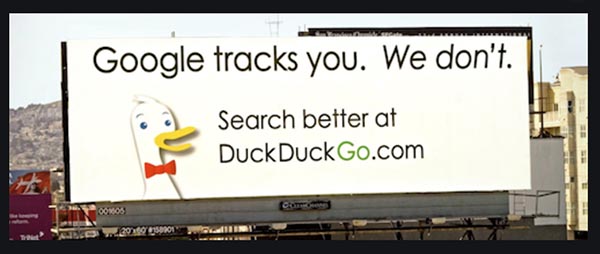Multi-touch campaigns aren’t just for direct mail and email anymore. DuckDuckGo has created a series of complementary but standalone billboards that, like any combination of channels, are designed to work together. Each billboard stands on its own, but the messaging from each builds on the other so that, as drivers view the billboards in sequence, they tell a story. In other words, DuckDuckGo is doing with billboards what marketers have been doing with direct mail, email, and other channels for years.
DuckDuckGo has made its name promising privacy from the prying eyes of Google and Facebook (check out one of its promo videos here.) Two years ago, it made marketing news with its billboards “Google tracks you. We don’t.” The other day, I saw version 2.0 of this approach as I drove the round trip from Maryland to Pennsylvania on Interstate 83. Two of the billboards were placed headed north and the third was placed headed south.

Source: Not taken while driving
The first sign I saw read, “It’s time to take back your privacy!” Then, a mile or two down the road, I saw another sign. I can’t remember exactly what it said, but it was something along the lines of, “Are you tired of being tracked?” Then on the way back, I saw the third billboard. It might have been the original, “Google tracks you. We don’t.” Or a line from its website: “Switch the search engine that doesn’t track you.” Or something similar.
Regardless of what the signs actually say (I was, in my own defense, driving at highway speeds), the point was this—the concept was gradually rolled out so that I could think about and process each component of the messaging over a span of miles. This allowed the company to tell a more complex story than could normally be grasped at a single viewing.
We do this in other areas of marketing. We call it multi-touch campaigns, integrated campaigns, and drip marketing. But who knew you could do it with billboards? Apparently, DuckDuckGo. The first sign caught my interest because it was different. The second really grabbed my attention because it was the second billboard I’d seen from the same company, but with different messaging, within a several minute span of time. Then on the way back, when I saw the third billboard, the entire picture came together and I realized what they were doing. I thought,” Wow! That’s cool.”
It makes me wonder. We’re used to the one-off billboard that makes its pitch as powerfully as possible in a single hit of the eyeballs. Coordinating multiple billboards is a more costly, but certainly highly effective, alternative. Is this an approach that other companies can benefit from? How about with other channels, like in-store signage? It’s an interesting thought. Do you know any other marketers who have tried it?










Discussion
By R. J. Caravan on Jul 24, 2020
Burma Shave Billboards famously dotted U.S. highways from the late 1920s to early 1960s ...
Discussion
Join the discussion Sign In or Become a Member, doing so is simple and free